Orange Marmalade Recipe (Quick Cooking, Low Sugar)
This easy orange marmalade recipe gives a light and sweet orange flavor with a lot less sugar than traditional recipes. It's a perfect way to capture citrus season. We use Pomona's Pectin to speed up cooking and reduce the sweetener.

Later in the post, we cover some marmalade history, and a traditional orange marmalade recipe.
What's the difference between orange jam and marmalade?
Fruit jam is made with chunks of fruit or whole fruits. (For instance, strawberry jam.) This also applies to marmalade, but marmalade includes the rind of the fruit for a stronger citrus flavor.
Traditionally, orange marmalade was made with Seville oranges, which are rather bitter. Those doing the preserving would slow cook the marmalade, sometimes for days, with plenty of sugar. The pips (seeds) were steeped for their natural pectin.
Now, Seville oranges are difficult to find in many areas (although they grow wild in some locations). We used sweet oranges, but you can also use blood oranges or other citrus.
We combine orange slices, orange peel and lemon juice for plenty of citrus flavor. Because of the added pectin, you don't need a chilled plate or candy thermometer to tell when the marmalade is ready.
How to Make Orange Marmalade
Our orange marmalade recipe is adapted from the book “Preserving with Pomona's Pectin“. Pomona's Pectin is my “go to” for jams and jellies, because it sets up with little or no added sweetener. Your preserves cook quickly, keeping their fresh fruit flavor.
This marmalade recipe makes 6-7 half-pint (8 ounce) jars. I process my jars in a boiling water bath canner, but it is okay to make a half batch and store it in the refrigerator.
Before you get started, prep your equipment and ingredients:
- Water bath canner
- Jar lifter
- Jar funnel
- Lid Lifter
- Canning jars and two piece canning lids
- 6-7 medium oranges, lemon juice, water, sugar and Pomona's pectin
See “How to Can Food at Home” for more information on canning equipment and safe canning tips.
Wash the oranges, scrubbing well to remove any preservative wax on the skin. Peel off thin strips of rind from two oranges with a vegetable peeler, leaving the white pith behind. Chop peel into thin strips.
Peel the oranges and remove the white pith and tough membranes. Segment or finely chop the fruit. If segmenting the oranges, opt for seven oranges. If you choose to cut the oranges, six should be enough.
In a large saucepan, combine the chopped fruit, sliced peels, 3 cups water and 3 teaspoons calcium water. Bring to a boil, reduce heat and simmer (covered) for 20 minutes to soften the peels, stirring occasionally. Add 3 tablespoons lemon juice.
Mix 2 1/2 cups sugar and 3 teaspoons pectin powder in a separate bowl. Bring fruit mix back to a boil over high heat. Slowly add pectin-sugar mixture, stirring constantly. Continue to stir vigorously for 1-2 minutes to dissolve pectin.
Bring orange marmalade back to a full boil. Boil for one minute, and then remove from heat.
Print Friendly Recipe
PrintOrange Marmalade
This easy orange marmalade recipe gives a light and sweet orange flavor with a lot less sugar than traditional recipes. It's perfect for citrus season.
- Prep Time: 15 minutes
- Cook Time: 30 minutes
- Total Time: 45 minutes
- Yield: 7 cups 1x
- Category: Marmalade
- Method: Canning
Ingredients
- 6–7 medium oranges
- 3 cups water
- 3 tablespoons lemon juice
- 3 teaspoons calcium water (included with Pomona's Pectin)
- 2 1/2 cups sugar
- 3 teaspoons Pomona's pectin powder
Instructions
Wash the oranges, scrubbing well to remove any preservative wax on the skin. Peel off thin strips of rind from two oranges with a vegetable peeler, leaving the white pith behind. Chop peel into thin strips.
Peel the oranges and remove the white pith and tough membranes. Segment or finely chop the fruit. If segmenting the oranges, opt for seven oranges. If you choose to chop the oranges, six should be enough.
In a large saucepan, combine the chopped fruit, sliced peels, 3 cups water and 3 teaspoons calcium water. Bring to a boil, reduce heat and simmer (covered) for 20 minutes to soften the peels, stirring occasionally. Add 3 tablespoons lemon juice.
Mix 2 1/2 cups sugar and 3 teaspoons pectin powder in a separate bowl. Bring fruit mix back to a boil over high heat. Slowly add pectin-sugar mixture, stirring constantly. Continue to stir vigorously for 1-2 minutes to dissolve pectin.
Bring orange marmalade back to a full boil. Boil for one minute, and then remove from heat.
To can your orange marmalade, ladle quickly into prepared jars, filling to 1/4 inch of top. Wipe jar rims and threads. Cover with two piece canning lids.
Process jars for 10 minutes in a boiling water bath canner. When processing time is done, let rest a few minutes in the water bath, then place jars on a towel on the kitchen counter. Allow to cool completely at room temperature.
Remove rings for storage. Wipe tops and test seals. Date and label and store in a cool, dark location. Best if used within 1-2 years.
If any jars did not seal, refrigerate and use within a month.
Notes
To substitute honey for sugar, use 1 cup to 1 1/2 cups honey, depending on how sweet you prefer your marmalade. This will slightly reduce the amount of finished product.
A Little Marmalade History
While I was researching recipes for orange marmalade, I took a peek into one of my favorite preserving books, “Jam and Jellies: 543 Recipes” by May Byron. If you love old fashioned preserving recipes, this book is a “must have”.
Originally printed in 1917 and republished by Dover Publications in 1975, this book is like a time capsule of preserving. You do need a basic knowledge of safe food preservation to adapt some of the recipes to current safety guidelines, but it's fascinating to look back at how home food preservation was done.
There are 23 different recipes for orange marmalade, plus grapefruit, lemon, peach, grape, apple, quince – even medlar – and many more. I've shared an excerpt below, along with the author's preferred orange marmalade recipe. (Some spacing and subheadings added for readability.)
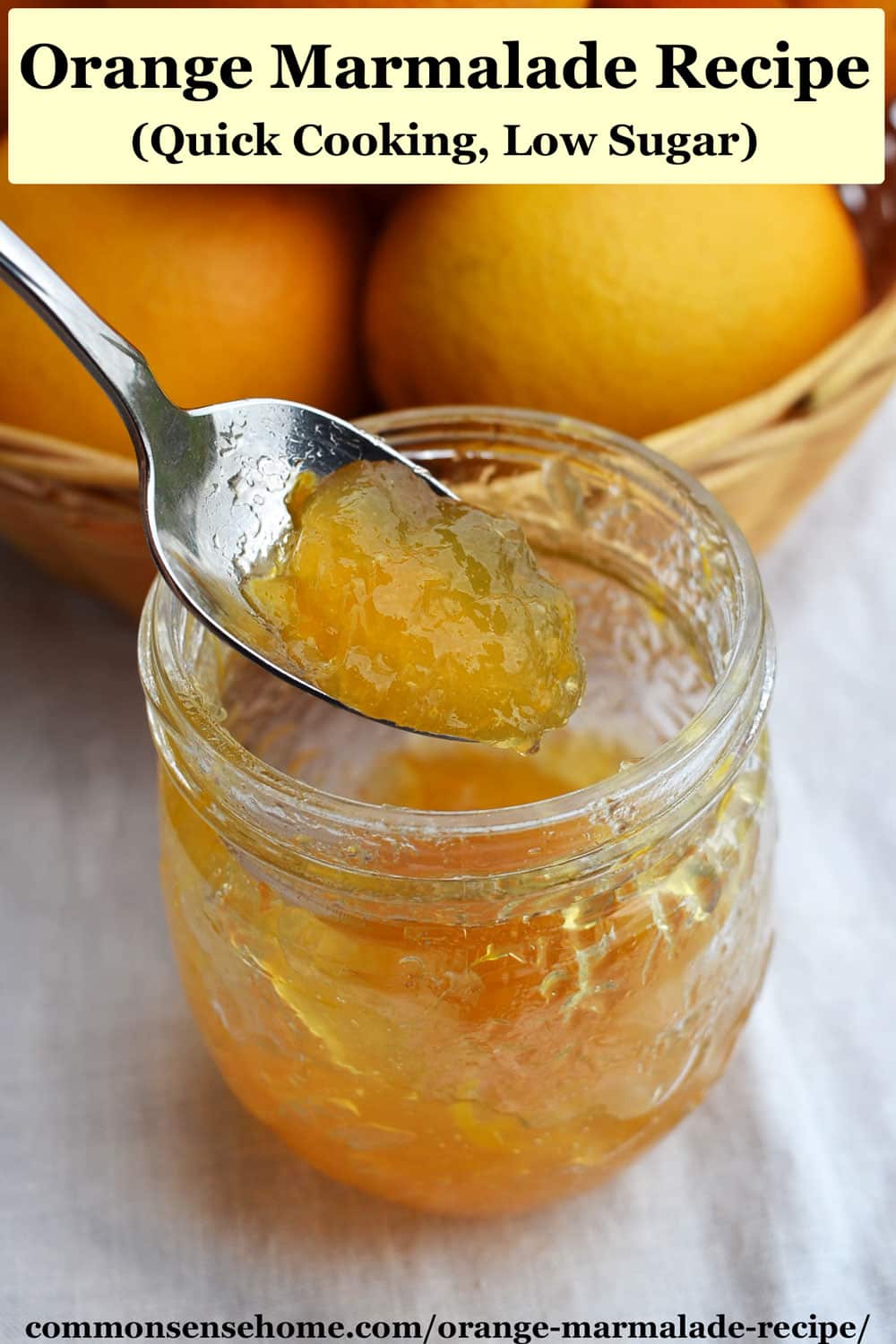
Notes on Orange Marmalade
The reader will probably be astonished to see this very large variety of recipes for orange marmalade, that indispensable article in the ordinary British household.
It may be said that no two recipes are alike. The oranges may be all Seville, or all sweet orange, or Seville intermingled with sweet oranges—or, either way, with or without the addition of lemons.
They may be sliced right through, or the peel removed and separately shredded. They may or may not be soaked overnight in the water wherein they are subsequently boiled, and this water may be salted, or not.
The proportion of water varies in almost every obtainable recipe; but weight for weight of fruit and water will make a solid marmalade, and, for a thinner one, the water may be increased to one pint and a half for every pound of pulp.
The treatment of the peel varies amazingly: it may be grated, minced, finely shredded, sliced in thick strips, or even cut in coarse squares, after the manner of “Oxford” marmalade.
The preserve itself may be opaque or transparent; the pulp may be passed through a sieve, or not; the peel may or may not be boiled separately from the pulp.
Don't Discard the Pips (Seeds)
The pips are too often thrown away; but they should always be steeped, overnight if possible, in a little water. This liquor will jellify, and should be strained off and added to the first boiling of the marmalade – not that a second boiling is always indicated!
Again, the proportion of sugar varies greatly, though “pound for pound ” is usually advised in the case of all-Seville oranges; and the length of boiling is never stated the same twice; and the amount to be made at a given time ranges from the employment of six to forty oranges.
When I was a country child, we made our marmalade fifty pounds at a time in the back-kitchen “copper,” but for the life of me I cannot remember the exact recipe.
On the whole, that recipe may be considered the most fruitful of success which implies the most trouble: i.e., the separate shredding and cooking of the yellow peel with white pith removed, the overnight steeping of the pulp – even to two nights running – and the addition of the sugar when the pulp and peel are cooked tender.
The first recipe given, perhaps, approximates most nearly to this ideal, but the others have all been tested by time and family favor—it is just a question of which you personally prefer.
A slicing machine will save much time and trouble if it be desirable to make orange marmalade on a large scale. A silver knife should be used for dealing with the pulp.
Wipe or wash the oranges perfectly clean. It is possible, with good management, to make both jelly and marmalade by straining off a certain amount of juice first.
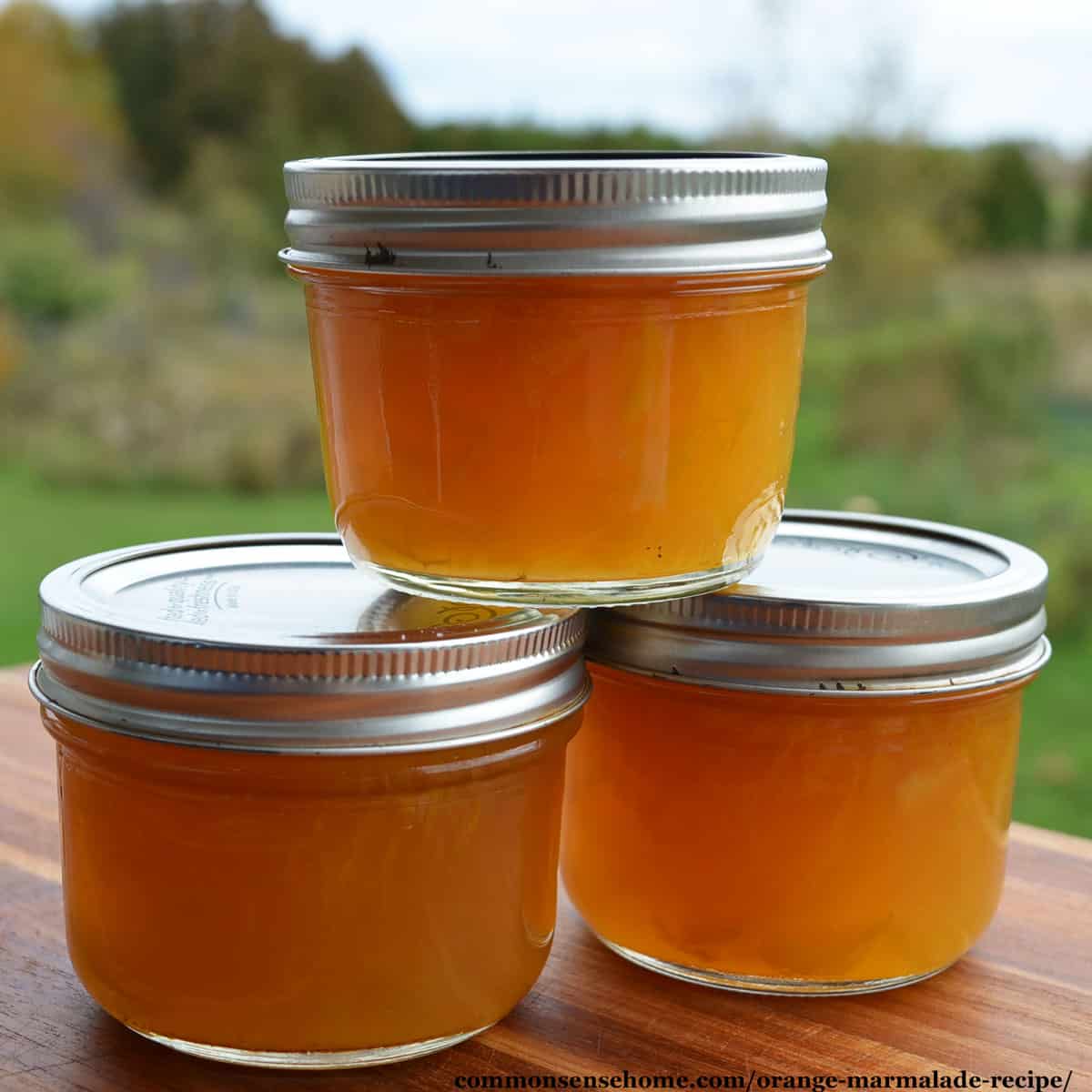
SEVILLE ORANGE MARMALADE, No. 1
Take twelve Seville oranges and three lemons; peel them, and cut up the peel into very thin strips.
Cut up the pulp into rough pieces with a silver knife, removing as much as possible of the white tissue. Put the pips and any odds and ends to soak in a little water.
Weigh, and place all in an earthen vessel. Pour an equal weight of water on, and leave for twenty-four hours.
Next day, add the water from pips, boil the whole till tender; put it back to stand another twenty-four hours.
On the third day, bring the orange mix to a boil, and add eight pounds of heated sugar.
Stir well till the sugar dissolves, and boil for forty-five minutes, or until the marmalade is of the required color and consistency.
More Jams, Jellies and Preserves
We have over 30 different jam, jelly and preserve recipes on the website, plus many other canning and preserving recipes, all listed by category on the Recipes and Kitchen Tips Index page. They include:
- 2 Ingredient Apple Jelly
- Dandelion Jelly – An Easy Flower Jelly Recipe with Less Sugar
- Cranberry-Pear Jam – Traditional and Low-Sugar
I hope you enjoy these orange marmalade recipes and a bit of preserving history. Let me know if you have any questions, or if you give the old fashioned recipe a try.

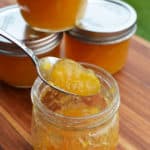
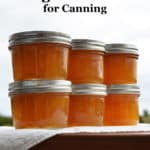
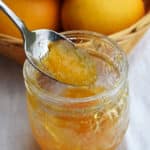

I like a tangier/more tart marmalade but the last 2 batches I made (not this recipe) were on the sweet side even though I used the lowest amount of sugar recommended. Are the Seville oranges more tart than others? Trying to figure my go to recipe so I’m not always in experiment mode. I do have Pomona pectin, so will be using that. thanks!
Seville oranges are indeed more tart, so much so that they are also known as bitter oranges or sour oranges, and almost never eaten raw.
Love orange marmalade and have not eaten any since I learned how much commercial orchards spray them. And I had to give up sucrose, no matter in which form.
Have you experimented with apple juice concentrate? Any opinions about how they measure up to your standard recipe?
Access to organic oranges is limited where I am. We see mostly organic navel oranges here. Would they would work, though tacking pits, maybe a little runnier?
Whenever I can find them, I love kumquats. The skin is so thin. It may be a purely lazy thought, but I wonder if since they are eaten whole, they wouldn’t need to be peeled, just sliced into rounds? And they have pits!
With the added pectin, navel oranges should work fine. If you want a thicker spread, you jut add more pectin.
Kumquat peels are edible, so they should make a fine marmalade.
How many cups of prepared orange fruit should this should be before adding anything.
I don’t normally measure, since a little more or less won’t ruin the recipe. A little over three cups is probably about right, because you want to end up with around 6 cups of cooked fruit mixed with water after it cooks down.